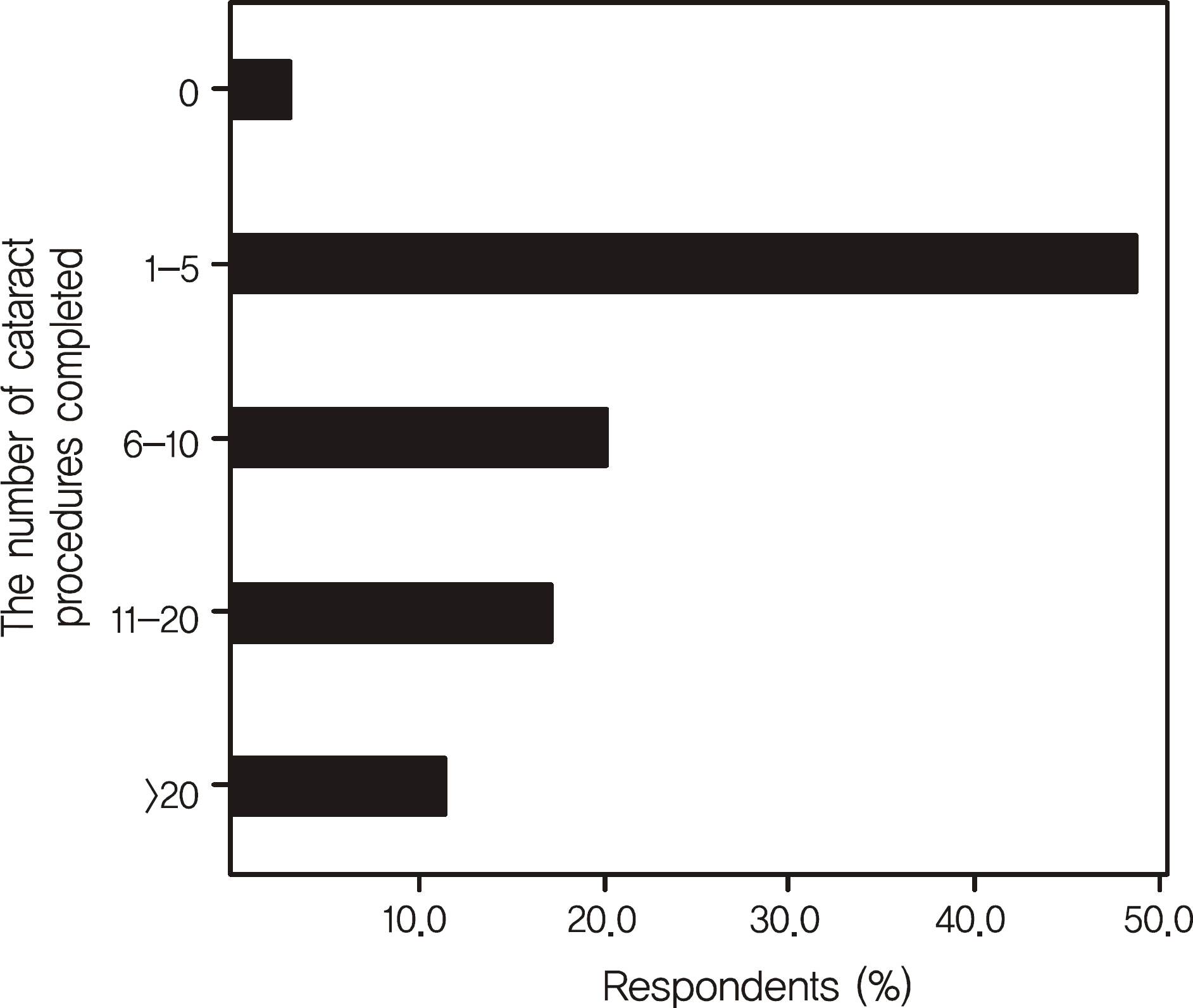J Korean Ophthalmol Soc.
2011 Apr;52(4):429-433.
A Survey Report on Cataract Surgical Experiences during Ophthalmology Residency in Korea
- Affiliations
-
- 1Department of Ophthalmology, Korea University College of Medicine, Seoul, Korea. crisim@korea.ac.kr
Abstract
- PURPOSE
To investigate cataract surgical experiences during ophthalmology residency in Korea.
METHODS
A survey regarding cataract surgical experiences during residency was sent to 4th year ophthalmologic residents (112) from April to September 2010.
RESULTS
Of the 112 individuals to whom the surveys were sent, 35 (31.3%) responded. The majority of the respondents (65.7%) performed their first cataract operation as the primary surgeon in their 4th year of residency. The majority of the respondents (42.9%) also thought that continuous curvilinear capsulorhexis (CCC) was the most difficult procedure followed by nucleus removal (31.4%). Fourteen respondents (40.0%) experienced loss of lens fragments into the vitreous cavity. Nine (25.7%) respondents had experienced performing ECCE (Extracapsular cataract extraction) during residency training. Also, 48.6% performed 1 to 5 cataract procedures during their entire residency training while 20.0% performed 6 to 10.
CONCLUSIONS
The experiences in cataract surgery during residency were investigated for the first time through a questionnaire survey. The Korean ophthalmology residency program needs to provide more opportunities for residents to perform cataract surgery during their training period.
Keyword
MeSH Terms
Figure
Reference
-
References
1. Park UC, Kwon JW, Han YK. Clinical results of posterior capsule ruptures in the first 1000 phacoemulsification cases. J Korean Ophthalmol Soc. 2005; 46:1270–5.2. Thomas R, Naveen S, Jacob A, Braganza A. Visual outcome and complications of residents learning phacoemulsification. Indian J Ophthalmol. 1997; 45:215–9.3. Tabandeh H, Smeets B, Teimory M, Seward H. Learning phacoemulsification: the surgeon-in-training. Eye. 1994; 8:475–7.
Article4. Tayanithi P, Pungpapong K, Siramput P. Vitreous loss during phacoemulsification learning curve performed by third-year residents. J Med Assoc Thai. 2005; 88:S89–93.5. Allinson RW, Metrikin DC, Fante RG. Incidence of vitreous loss among third-year residents performing phacoemulsification. Ophthalmology. 1992; 99:726–30.
Article6. Cruz OA, Wallace GW, Gay CA, et al. Visual results and complications of phacoemulsification with intraocular lens implantation performed by ophthalmology residents. Ophthalmology. 1992; 99:448–52.
Article7. Corey RP, Olson RJ. Surgical outcomes of cataract extractions performed by residents using phacoemulsification. J Cataract Refract Surg. 1998; 24:66–72.
Article8. Ng DT, Rowe NA, Francis IC, et al. Intraoperative complications of 1000 phacoemulsification procedures: a prospective study. J Cataract Refract Surg. 1998; 24:1390–5.
Article9. Paik HJ, Song HJ, Shyn KH. 2007 survey for KSCRS members: current trends in cataract surgery in Korea. J Korean Ophthalmol Soc. 2009; 50:1624–31.10. Shyn KH, Chi MJ, Sohn HJ. 2004 survey for KSCRS members: current trends in cataract surgery in Korea. J Korean Ophthalmol Soc. 2006; 47:214–20.11. Lee DY, Roh JH, Shyn KH. 2005 survey for KSCRS members: current trends in cataract surgery in Korea. J Korean Ophthalmol Soc. 2007; 48:485–92.12. Moon JH, Shyn KH. 2006 survey for KSCRS members: current trends in cataract surgery in Korea. J Korean Ophthalmol Soc. 2009; 50:1617–23.13. Shyn KH, Bae JY, Moon HS. 2003 survey for KSCRS members: current trends in cataract and refractive surgery in Korea. J Korean Ophthalmol Soc. 2005; 46:35–44.14. Quillen DA, Phipps SJ. Visual outcomes and incidence of vitreous loss for residents performing phacoemulsification without prior planned extracapsular cataract extraction experience. Am J Ophthalmol. 2003; 135:732–3.
Article15. Bhagat N, Nissirios N, Potdevin L, et al. Complications in resi-dent-performed phacoemulsification cataract surgery at New Jersey Medical School. Br J Ophthalmol. 2007; 91:1315–7.
Article16. Zhou AW, Noble J, Lam WC. Canadian ophthalmology residency training: an evaluation of resident satisfaction and comparison with international standards. Can J Ophthalmol. 2009; 44:540–7.
Article17. Najjar DM, Awwad ST. Cataract surgery risk score for residents and beginning surgeons. J Cataract Refract Surg. 2003; 29:2036–7.
Article18. Blomquist PH, Sargent JW, Winslow HH. Validation of Najjar- Awwad cataract surgery risk score for resident phacoemulsification surgery. J Cataract Refract Surg. 2010; 36:1753–7.
- Full Text Links
- Actions
-
Cited
- CITED
-
- Close
- Share
- Similar articles
-
- Iatrogenic Blepharoptosis after Cataract Surgery
- Delivering bad news to a patient: a survey of residents and fellows on attitude and awareness
- Clinical Studies on Hyphema in The Complications of Cataract Extraction
- 2004 Survey for KSCRS Members: Current Trends in Cataract Surgery in Korea
- Research on the Actual Educational Condition of Contact Lens in Korean Ophthalmology Residency Training Hospitals





